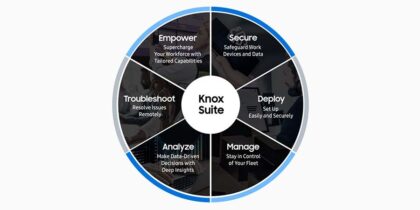Without a mobile device enrollment program for enterprise mobility management (EMM), many organizations will find themselves struggling to account for all the devices that are on their network. Such a program allows organizations not only to account for all the devices that are in use, but also it ensures that they do not introduce security risks through misconfigurations or malware because they lack the appropriate security controls.
This is increasingly important for businesses, who are equipping large numbers of employees with mobile devices hooked up to the company network. According to a 2014 statement from Gartner, 75 percent of breaches seen in recent years involved a compromised endpoint.
Efficiency Gains From Mobile Device Enrollment
For a large organization with hundreds or even thousands of users, a device enrollment program makes perfect sense. Without one, the IT department can become overwhelmed with time-consuming, monotonous tasks that, by themselves, add little value to the organization. This is especially true when users bring multiple devices to the workplace, such as a smartphone and a tablet computer they purchased themselves. As such, a device enrollment plan is essential for implementing a secure BYOD program since it will streamline tasks associated with enrollment and provisioning through self-service.
With the self-service capabilities that mobile device enrollment programs offer, employees simply need to click on a link provided to them via a web app or near-field communication when they attempt to access the network. Clicking on that link will assign a license to the device that they are using, which can then be done for all of their devices, with a separate license assigned to each. They will then be able to gain access to corporate-approved apps through the corporate portal, through which they can access the data for which they have been granted entitlements. If the corporate content on a device has been wiped for security reasons, the software will automatically re-register the user when they reconnect to the network, greatly improving ease of use.
Security can also be vastly improved for BYOD programs using security tools such as those offered within the Samsung KNOX platform. This is done by automatically installing containers on the device, keeping work and leisure applications and data separate so that sensitive information can be better controlled and secured. Organizations will be able to better control the security posture of all devices on the network, ensuring that these have the latest security policies, patches and updates installed, in order to protect corporate data and to be compliant with company policy.
Integration With Active Directory
For any organization, and particularly for large organizations with hundreds, if not thousands of users and devices to manage, one particular feature to look for is integration with LDAP directory services. The most common example of this is Active Directory. Mobile device management technology, such as solutions offered on the Samsung KNOX platform, enable corporate policies for access control to be managed and enforced. This includes single sign-on to applications and resources so that the Active Directory credentials secure access to the work container on each device. This means that users have fewer passwords to manage, which greatly increases ease of use as well as security.
In today’s world, where smartphones are the devices of choice for many businesses, mobile device enrollment should be considered to be an essential part of any enterprise’s mobile device management rollout. It will not only provide organizations with the peace of mind that there are no rogue devices connected to their sensitive resources, but it will also make life easier for users and for the IT department, as it will no longer spend valuable time on the basic chores associated with registering devices.






